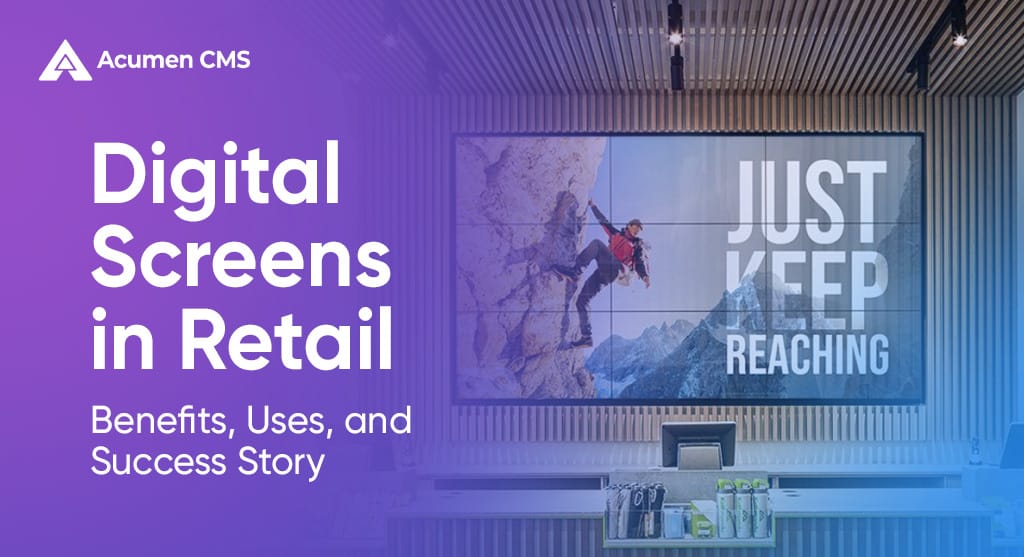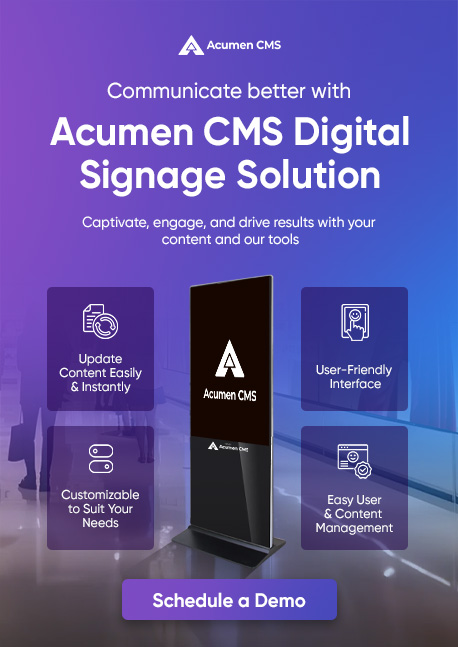In India, retail digital signage is helping companies to engage more customers in their day-to-day lives. The screens used for advertisement assist them in presenting engaging in-store experiences.
And the global digital signage market is forecasted to reach $23.05 billion by 2025. That implies that in the future, retail digital signage is not a nice-to-have anymore; it’s a strategic way to acquire, engage, and convert customers effectively.
Therefore, if you are interested in learning how digital signage technology can drive your business, find below all the details regarding digital signage.
What Is Digital Signage in Retail?

Retail digital signage is the application of LEDs or LCDs to show multimedia content in the form of advertisements, product details, or interactive content within retail settings.
Unlike static posters or printed formats, digital displays enable retailers to change content without being physically present, initiate targeted campaigns, and design engaging experiences.
Today’s retail signage solutions usually consist of
- High-definition digital screens
- A Content Management System (CMS) such as Acumen CMS
- Internet or cloud connectivity for remote control
- Digital signage fills the space between online activity and in-store interaction, keeping your brand current and customer-focused.

Why Does Retail Need Digital Signage in 2025?
There are many outlets, from fashion stores to grocery stores, in India where companies are using digital screens. It not only engages more customers but also transforms the in-store experience for the customers.
- Catches attention immediately: Motion graphics and colorful visuals beat static displays in grabbing customers’ attention.
- Gives real-time updates: Update promotions or content in mere seconds.
Omnichannel integration: Time in-store displays with online campaigns for an immersive brand experience.
Digital vs Traditional Signage: A Quick Comparison
Before getting into the benefits of digital screens, it’s important to understand how they are better than traditional signage solutions.
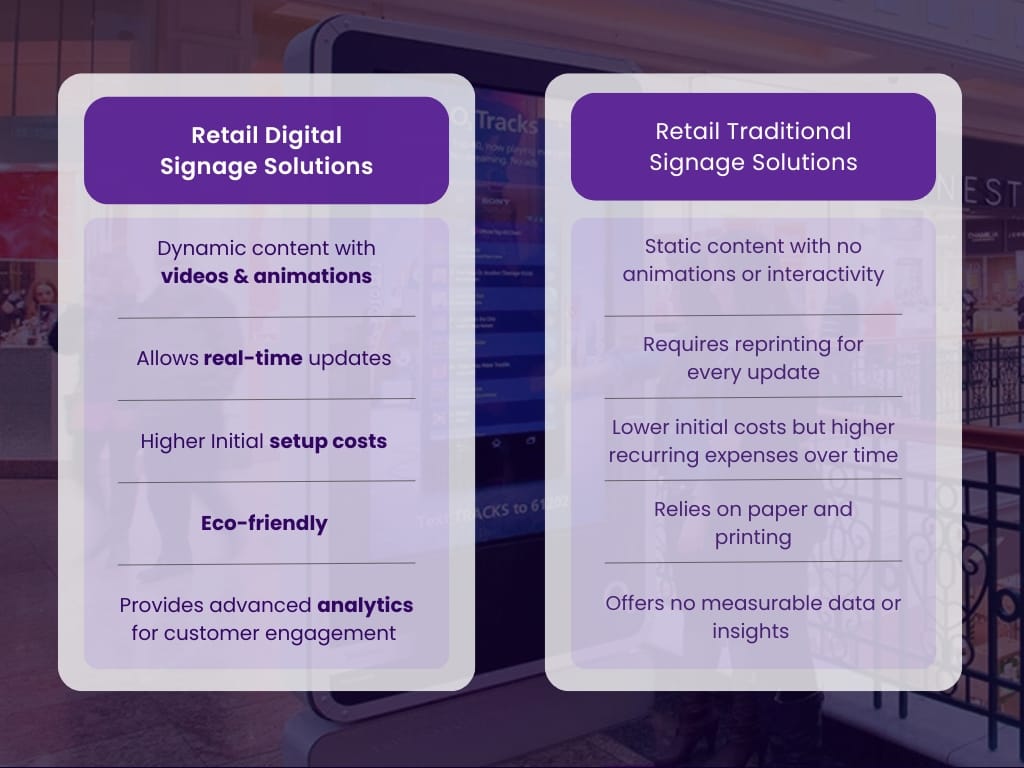
Benefits of Digital Signage in Retail Stores
Digital signage displays in retail are transforming how businesses interact with customers. Let’s look at the key benefits that will make digital signage for retail a necessity in 2025.
Drive Foot and Store Traffic
With the live content presented via shopfront, digital signage can attract more pedestrians inside the store. Whatever it is, a flash sale, hot product, or holiday greeting, attention-grabbing screens provide the “nudge” necessary to turn heads and welcome buyers into the store.
Enhance Customer Interaction & Dwell Time
Screens installed in strategic touchpoints like beside product stands or waiting areas retain customers’ interest while they explore. Display how-to videos, conduct interactive games, or offer product comparisons to delay the departure of the customer and drive purchases.
Real-Time Promotions & Flash Sales
Digital signage enables instant refreshes. Must advertise a “Buy 1 Get 1” offer at 5:00 PM? It only takes a click. Retailers can offer unmatched promotional agility by activating localized or time-sensitive promotions without any print lag.
Brand Storytelling & Consistency
Digital screens enable consistent delivery of your brand message. Tell your story, values, or behind-the-scenes content in visually engaging formats. Build emotional connections that foster brand loyalty.
Reduce Operational Cost
The initial installation might cost; digital signage significantly minimises ongoing printing expenses as well as labour. A unified CMS such as Acumen CMS enables effortless scheduling and automation, thus enhancing long-term operational efficiency.

Types of Digital Signage Used in Retail
All digital screens are not created equal; each is used for a special retail need. Let’s go through the most popular types and how they make shopping more enjoyable.
- Interactive Kiosks

Touchscreen kiosks enable shoppers to explore stock, view product specifications, or even order, making for an efficient, tailored self-service experience.
- Digital Menu Boards

Perfect for food retail or fast fashion, digital boards show dynamic menus, combos, or stock in real time.
- Video Walls
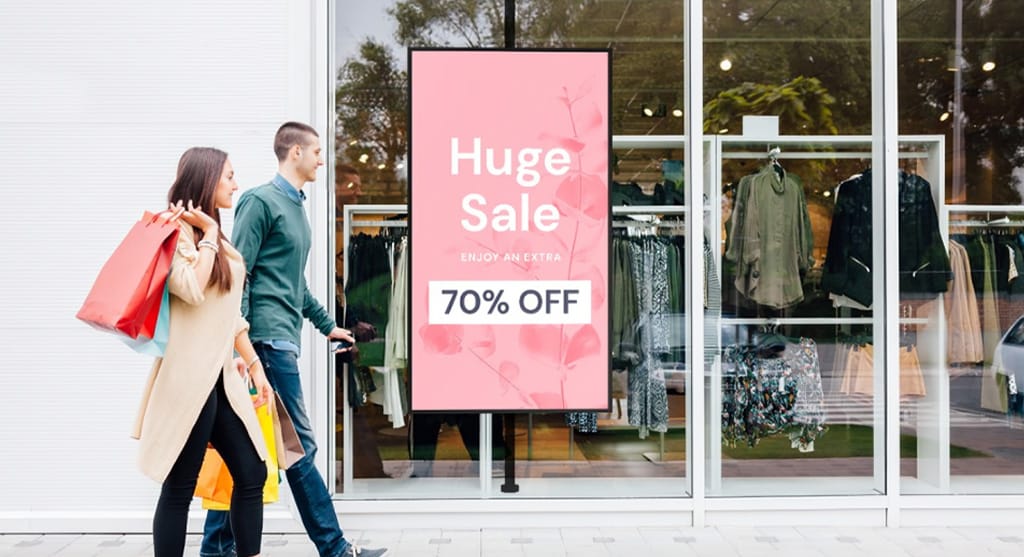
Big-screen displays, situated at entrances or opposite checkout counters, provide high-impact branding or promotion messaging that enhances store visuals.
- Shelf-Edge Displays
Installed directly on store shelves, these small screens drive promotions, upsell accessories, and display product comparisons.
- Window Displays
Confronting outward, these daylight-readable screens capture outside foot traffic and act as digital billboards, even in the daylight.
How to Integrate Digital Screens in Your Retail Store?
The Indian market is adopting this visual display system to modernise their in-store communication. However, getting the setup right requires more than just mounting a screen. To get the full business value, you must plan screen usage, content management, and placement based on customer flow and product strategy.
Here are five clear steps to help integrate the signage system into your business.
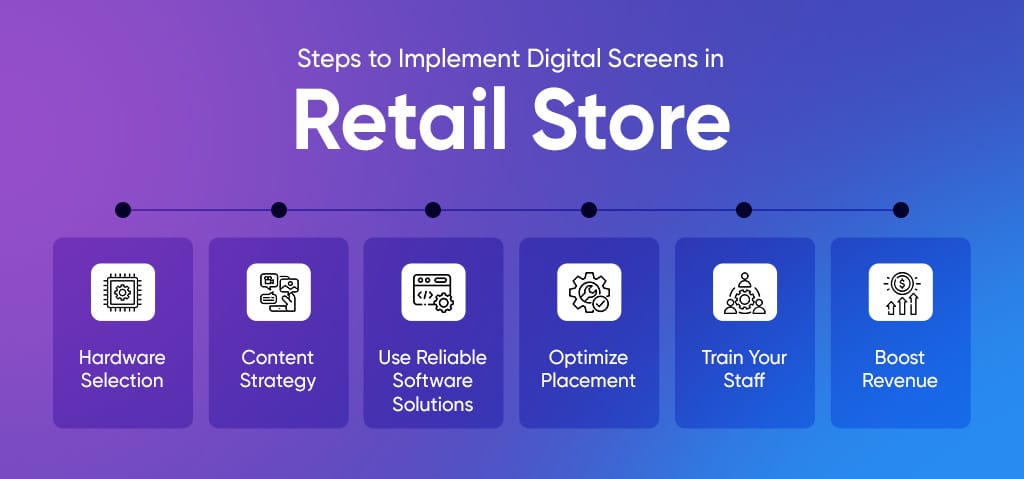
1. Select the Right Hardware
Choose screen types based on store layout, visibility, and purpose. Use LED screens for branding and promotions in large areas or shopfronts. Place interactive kiosks in zones where customers seek product information or want to self-browse.
Screen size and resolution should align with the viewing distance and the environment. This step ensures that your display investment delivers visibility and value from day one.
2. Build a Content Strategy
Decide what the in-store screens will show to your audience. You can display pricing updates, product benefits, seasonal offers, customer stories, or demo videos.
Refresh content regularly to avoid repetition. Match promotions with local trends, product launches, or regional events.
Your digital display content should always support product movement and brand consistency across locations.
3. Use a Reliable Digital Signage Software
A digital signage system needs a robust backend to work smoothly. Install a Content Management System (CMS) that helps you manage screen content across all outlets.
With a system like Acumen CMS, you can:
- Upload and organize content
- Control screen schedules remotely
- Access performance reports
- Sync live data through API integrations
- Using the right CMS makes your signage system scalable and efficient.

4. Place Screens Strategically
Placement affects impact. Install digital screens in high-footfall areas such as entrances, billing counters, or near fast-moving SKUs. Use ceiling mounts or shelf-integrated displays to guide customers through your product flow.
Some experimentation may be needed in the early days. If you’re unsure where to place displays for maximum response, our experts at Acumen can guide you with data-backed screen placement plans.
5. Train Your Store Staff to Use the Screens
Invest time in training your in-store teams. Staff should know how to operate the signage and CMS, to update content, and to troubleshoot basic screen issues.
When staff understand how screens work, they can align daily operations with display objectives. This reduces dependency on external help and improves in-store responsiveness.
Success Story: Retailer Who Nailed It

Continental Coffee, one of India’s largest retailers, was established in 1995 by Challa Rajendra Prasad. It has leveraged digital screens to positively transform the in-store experience for its customers.
Its screens offer a premium experience to its customers to explore its products. This has not only enhanced customer satisfaction but also boosted its revenue significantly.

(Source – Statista)
Continental Coffee’s use of digital screens positions the brand as progressive, hence memorable to its customers, and, above all, improves their experience within the stores.
This achievement underscores how digital signage can revamp retail engagement and drive measurable business results.
Future Trends in Retail Digital Signage
The next chapter for digital displays in retail will be written by innovative technologies beyond static marketing:
- AI-based personalisation: Display customised content based on demographics or history.
- Touchless engagement: Voice-activated or motion-sensing screens after the pandemic.
- Data analysis: Monitor engagement, dwell time, and conversions through embedded sensors and analytics software.

Why Choose Acumen CMS for Retail Digital Signage?
Acumen CMS streamlines the whole process from content creation to screen deployment. Whether you have one boutique or hundreds of stores, it allows you to create, manage, and update all your retail digital signage in real-time.
- Easy-to-use dashboard: No technical know-how required
- Content scheduling & automation: Schedule weekly or monthly campaigns with ease
- Custom templates: Drag-and-drop templates for advertisements, sales, or product promotions
- Performance analytics: Monitor which screens and content work best.
Conclusion
In an era where customer focus is temporary, digital display in retail delivers the visual effect and engaging interaction to remain competitive. They enhance traffic, drive conversions, and create strong brand impressions.
By combining with a robust platform like Acumen CMS, retailers gain complete command of their signage strategy for sustained growth.
Frequently Asked Questions (FAQs)
No. With flexible solutions such as Acumen CMS, even small retailers can roll out effective screens affordably.
With a CMS, content can be changed remotely in real time on multiple screens, locations, or time zones.
You can show combined product videos, promotions, testimonials, instructional guides, and seasonal promotions to keep it interesting.
Yes. From boutiques to supermarkets, any store that wishes to update its customer experience can use digital screens.

